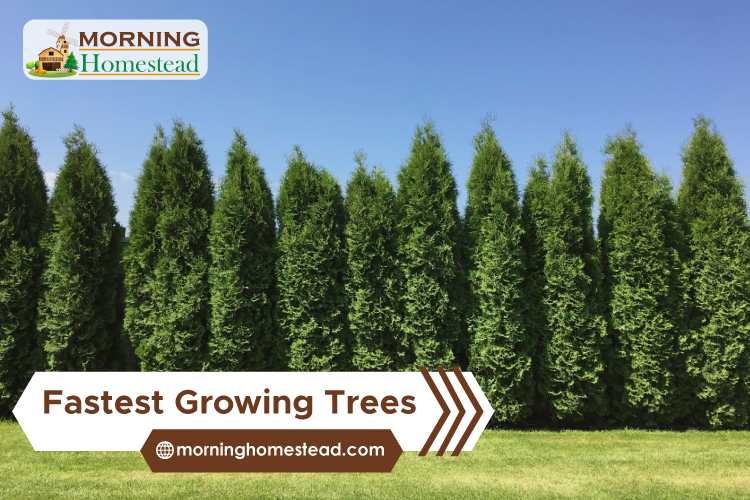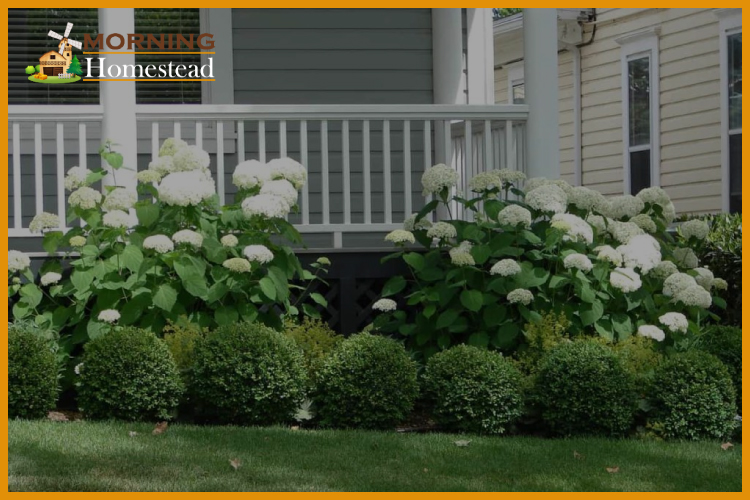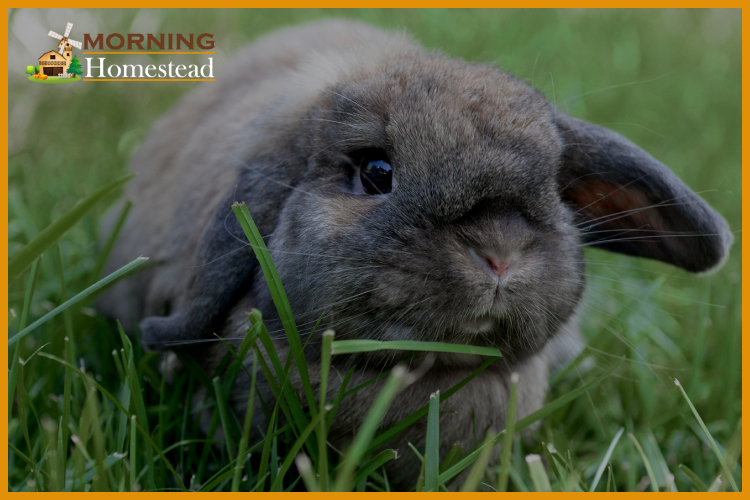Last Updated on June 10, 2023 by Georgie Smith
Fastest growing trees are a great option for those who want to get results quickly in their garden. Whether you’re looking to add shade, privacy, or visual interest to your yard, there are plenty of fast-growing tree varieties. In this article, you’ll explore the top eight fastest-growing trees for gardening and some tips for planting and caring for these speedy specimens. So, let’s dive in and discover how to create a lush, vibrant garden with the power of fast-growing trees!
Importance of Trees in Gardening
Fastest growing trees play an important role in gardening, not only because they provide fast results but also because they offer a host of benefits to your garden and the environment. Trees are essential components of any garden, providing a range of services such as shade, shelter, privacy, and enhancing the overall aesthetic appeal of the space.
In addition, trees also help to purify the air, sequester carbon dioxide, and promote biodiversity by providing habitats for birds and other wildlife. Fast-growing trees, in particular, are great options for homeowners who want to see results quickly without waiting years for their trees to grow to maturity.
With their rapid growth rates, fast-growing trees can provide the benefits that other slower-growing trees offer, allowing you to enjoy a lush, vibrant garden in a shorter time. Whether you want to create a privacy screen, add shade, or beautify your garden, fast-growing trees can help you achieve your goals quickly.
What are the fastest growing evergreen trees?
Some fastest-growing evergreen trees include the Leyland Cypress, Thuja Green Giant, and the Arizona Cypress. These trees are popular for homeowners who want to quickly establish a privacy screen or windbreak on their property. However, it’s important to note that fast growth can sometimes mean weaker wood and susceptibility to certain pests and diseases. Hence, it’s important to research each tree’s specific needs and characteristics before planting.
Top Fastest Growing Trees for Your Garden
Many options exist if you want to add some quick-growing trees to your garden. Some of the fastest growing pine trees in Texas include the Loblolly Pine and the Slash Pine, while some of the fastest-growing hardwood trees include the American Sycamore and the Red Maple. These trees are great for providing shade and beauty to your landscape in a short amount of time. Some of them are given below:
Hybrid Poplar Trees
Hybrid Poplar Trees, or Populus x Canadensis, are popular for homeowners and gardeners looking for fast-growing trees. These trees are a cross between two species of poplar trees and offer a range of benefits for gardens and landscaping projects.
One of the main characteristics of hybrid poplar trees is their rapid growth rate. These trees can grow up to 8 feet annually, making them an excellent choice for quickly establishing a privacy screen, windbreak, or shade tree. They are also known for tolerating various growing conditions, including poor soil, drought, and pollution.
Hybrid poplar trees are typically hardy in growing zones 3-8, making them suitable for various climates across North America. They thrive in full sun and can grow up to 50 feet tall and 30 feet wide at maturity, providing ample shade and visual interest in any landscape.
Another benefit of hybrid poplar trees is their attractive foliage. These trees have large, heart-shaped leaves that turn golden yellow in the fall, adding a pop of color to any garden. They are also known for their ability to absorb pollutants from the air and soil, making them a popular choice for urban landscaping projects.
If you’re considering planting hybrid poplar trees in your garden, it’s important to note that they are deciduous and will lose their leaves in the fall. However, their fast growth rate and attractive foliage make them an excellent choice for homeowners and gardeners looking for a low-maintenance, high-impact tree.
Willow Trees
Willow trees are popular due to their graceful appearance, fast growth, and hardy nature. They belong to the genus Salix and are part of the Salicaceae family. The botanical names of willow trees can vary depending on the specific species. Still, some common names include white willow (Salix alba), weeping willow (Salix babylonica), and black willow (Salix nigra).
Willow trees are known for their long, narrow leaves, typically green or gray-green. They also have flexible branches that often droop down to create a graceful, flowing appearance. Depending on the species, willow trees can grow from 6 to 60 feet tall, with a spread ranging from 6 to 50 feet.
Willow trees are hardy and can grow in various growing zones, from USDA zones 2 through 9. They prefer moist, well-drained soil but can tolerate poorly drained soil and flooding. Some willow species, such as the black willow, are adapted to grow in wetland areas.
Overall, willow trees are a great choice for gardeners looking for fast-growing, hardy trees that provide beauty and function. With their graceful appearance and adaptability to different growing conditions, it’s no wonder that they continue to be a popular choice among gardeners of all skill levels.
Weeping Willow Trees
Weeping Willow trees are one of the fastest growing trees you can add to your garden. Their botanic name is Salix Babylonica, and they are native to China. These trees have long, sweeping branches that hang down to the ground, giving them their distinctive weeping appearance. Weeping Willow trees can grow up to 50 feet tall and spread to 35 feet.
Weeping Willow trees are adaptable to various soil types but prefer moist, well-drained soil. They are hardy in growing zones 6-8, which means they can tolerate cold temperatures down to -10°F. One thing to remember when planting Weeping Willow trees is their tendency to seek out water sources.
They have a large root system that can invade septic systems, water lines, and drainage fields, so be sure to plant them away from these areas. These trees can grow up to 8 feet per year under optimal conditions, meaning you can enjoy a mature tree in your garden in just a few years. This makes them a great choice to quickly add height and shade to your garden.
Overall, Weeping Willow trees are an excellent choice for gardens where you want fast growth and a unique, eye-catching tree. These trees will make a statement in any garden with their distinctive weeping branches and rapid growth rate. Just be sure to plant them away from underground water sources to prevent damage to your property.
Leyland Cypress Trees
Leyland Cypress trees, known by their botanical name Cupressus × Leylandii, are popular as fast-growing evergreen trees. These trees are a hybrid cross between two other Cypress trees, the Nootka Cypress and the Monterey Cypress. These trees are known for their dense, fast-growing foliage and ability to thrive in various growing conditions.
One of the key characteristics of Leyland Cypress trees is their rapid growth rate. These trees can grow up to three feet per year and reach heights of up to 70 feet at maturity. Leyland Cypress trees also have a dense growth habit, making them popular for creating privacy screens or windbreaks.
These trees are native to the Mediterranean region but can thrive in various growing zones. They are typically hardy in USDA growing zones 6-10, which includes most of the southern United States. However, they can also be grown successfully in other regions with proper care and maintenance.
In addition to their fast growth rate and dense foliage, these trees are known for their disease resistance and tolerance for various soil types. They can grow in acidic and alkaline soils and tolerate wet and dry conditions. They also have a long lifespan; some trees live up to 50 years or more.
Overall, Leyland Cypress trees are a versatile and popular choice for gardeners looking for the fastest-growing evergreen trees with dense foliage and various growing conditions.
Dawn Redwood Trees
Dawn Redwood trees are some of the fastest growing trees in the world, making them an excellent choice for gardens where you want to see rapid growth and transformation. The botanic name for the Dawn Redwood tree is Metasequoia Glyptostroboides, and they are a deciduous conifer that is native to China.
These trees can grow up to 100 feet tall and have a distinctive pyramidal shape with soft, fern-like needles that turn bronze in the fall. They are also known for their unique bark, which is reddish-brown and deeply furrowed.
Dawn Redwood trees can grow in various soil types but prefer moist, well-drained soil. They are also relatively tolerant of pollution, making them a good choice for urban gardens. These trees are hardy in growing zones 5-8, so they can tolerate cold temperatures down to -20°F.
This tree can grow up to 5 feet per year under optimal conditions, meaning you can enjoy a mature tree in your garden in just a few years. This makes them a great choice to quickly add height and structure to your garden.
Overall, Dawn Redwood trees are an excellent choice for gardens where you want fast growth and a unique, eye-catching tree. With their distinctive shape, soft needles, and rapid growth rate, these trees will make a statement in any garden.
Northern Catalpa Trees
Northern Catalpa trees, also known as Catalpa speciosa, are one of the fastest growing trees you can plant in your garden. These trees are native to the central and eastern parts of the United States and are known for their large, heart-shaped leaves and showy white flowers that bloom in the summer. The Northern Catalpa tree can grow up to 70 feet tall and has a spread of up to 50 feet.
Northern Catalpa trees are hardy in growing zones 4-8, so they can tolerate cold temperatures down to -30°F. They prefer full sun to partial shade and well-drained soil. One thing to remember when planting these trees is their susceptibility to damage from wind and ice. Their brittle branches can snap in high winds or heavy ice, so plant them away from areas where falling branches could be a hazard.
Despite this, Northern Catalpa trees are popular for those who want a fast-growing tree that provides plenty of shade and beauty. With their large leaves and showy flowers, they are sure to make a statement in any garden. Their fast growth rate means you won’t have to wait long to enjoy their benefits.
Royal Empress Trees
The Royal Empress tree, scientifically known as Paulownia Tomentosa, is one of the fastest growing trees in the world, making it a popular choice for the people who want quick results. These trees are native to China and have unique characteristics that make them a great addition to any garden.
Royal Empress trees can grow up to 50 feet tall and spread to 30 feet. They are known for their large, heart-shaped leaves and clusters of purple flowers that bloom in the spring. These trees prefer full sun and well-drained soil, and they are hardy in growing zones 5-9. One thing to remember when planting these tree is that they can be invasive in some areas.
Check with your local extension office before planting to ensure they suit your location. Despite their invasive tendencies, Royal Empress trees are a beautiful addition to any garden. With their fast growth rate and showy flowers, they will make a statement in your landscape.
Tulip Poplar Trees
Tulip Poplar trees, also known as Liriodendron Tulipifera, are one of the fastest growing trees you can plant in your garden. These trees are native to the eastern United States and are known for their tall, straight trunks and tulip-shaped flowers that bloom in the spring.
Tulip Poplar trees can grow up to 100 feet tall and spread to 50 feet. They prefer full sun and well-drained soil and are hardy in growing zones 4-9. With their fast growth rate and unique beauty, this tree is a great choice for anyone looking to add a statement tree to their landscape.
Factors to Consider When Choosing Fastest Growing Trees
Several important factors must be considered when choosing the fastest growing trees to plant in your garden. Here are some key things to keep in mind:
- Growth Rate: The first factor to consider is the tree’s growth rate. Fast-growing trees can vary in their growth rates, so choosing a tree that will grow at a rate that meets your needs is important.
- Size: Another important factor to consider is the tree’s ultimate size. You’ll want to choose a tree that will fit well in your garden and won’t outgrow its space over time.
- Soil Type: Different trees thrive in different types of soil, so it’s important to choose a tree that is well-suited to the type of soil in your garden.
- Climate: Your region’s climate can also impact the growth and health of your trees, so it’s important to choose a tree well-suited to your area’s climate conditions. Some of the most beautiful fastest growing trees for tropical climate include the Royal Poinciana, the Jacaranda, and the Golden Shower Tree.
- Maintenance: Some fast-growing trees require more maintenance than others, so it’s important to choose a tree that fits your level of expertise and the amount of time and effort you’re willing to put into maintaining it.
- Purpose: Finally, consider the purpose of the tree. Are you planting it for shade, privacy, aesthetics, or another reason? Choosing a tree that meets your specific needs will ensure that you benefit most from it.
By considering these factors when choosing the fastest growing trees to plant in your garden, you can ensure that you choose a tree that will thrive in your garden and provide the benefits you’re looking for. A fast-growing tree is perfect whether you’re looking for shade, privacy, aesthetics, or other benefits.
Benefits of Fastest Growing Trees
Fast-growing trees offer a range of benefits that make them an attractive option for houseowners looking to enhance their outdoor space quickly. Here are different ways in which fast-growing trees can benefit your garden:
Provide Shade: Fast-growing trees can quickly provide much-needed shade in your garden, helping to keep you cool and protected from the sun’s harmful rays.
Create Privacy: With their rapid growth rates, fast-growing trees are ideal for creating a natural privacy screen around your garden, shielding you from the prying eyes of neighbors and passersby.
Enhance Aesthetics: Fast-growing trees can quickly add beauty and visual interest to your garden with their lush foliage and interesting shapes and textures.
Increase Property Value: A well-maintained garden with fast-growing trees can significantly increase the value of your property, making it more attractive to potential buyers.
Improve Air Quality: Trees help to purify the air by absorbing carbon dioxide and other pollutants, helping to improve the overall air quality in your garden and surrounding area.
Reduce Noise Pollution: Fast-growing trees can help to reduce noise pollution, acting as a natural sound barrier and muffling unwanted noises from traffic, neighbors, or other sources.
Prevent Soil Erosion: The roots of fast-growing trees can help stabilize the soil in your garden, preventing erosion and soil loss.
Provide Habitat: Trees provide essential habitats for birds, insects, and other wildlife, helping to promote biodiversity and create a thriving ecosystem in your garden.
Reduce Energy Costs: Fast-growing trees can help to reduce your energy costs by providing shade in the summer, reducing the need for air conditioning, and blocking cold winds in the winter, reducing the need for heating.
Offer Health Benefits: Spending time in a garden with fast-growing trees has been shown to have a range of health benefits, including reducing stress, lowering blood pressure, and boosting overall well-being.
As you can see, many compelling reasons exist to consider planting fast-growing trees in your garden. Their rapid growth rates and numerous benefits make them a smart choice for any gardener looking to quickly and easily enhance their outdoor space.
Tips for Planting and Caring for Fast-Growing Trees
Planting and caring for the fastest-growing trees requires extra attention to ensure they grow healthy and strong. Here are some tips to help you get started:
Choosing the Right Location
Fast-growing trees require plenty of sunlight and room to grow. Make sure you choose a location that provides at least 6 hours of direct sunlight daily and enough space for the tree to grow to its full height and width.
Preparing the Soil
Before planting your fastest growing trees, prepare the soil by removing weeds or debris and adding a layer of compost or other organic matter. This will help to provide the tree with the nutrients it needs to grow strong and healthy.
Watering and Fertilizing
Fast growing trees require regular watering, especially during the first few years of growth. Ensure to water your tree deeply once a week or more often during hot, dry weather. You can also fertilize your tree with a slow-release fertilizer to help it grow strong and healthy.
Pruning and Trimming
Thefast growing trees may require regular pruning and trimming to maintain their shape and prevent overcrowding. Make sure to prune your tree during the dormant season, and only remove a small amount of growth at a time to avoid damaging the tree.
Protecting from Pests and Diseases
Fast-growing trees may be more susceptible to pests and diseases than slower-growing trees. Monitor your tree for signs of damage or infestation, and take steps to protect it from pests and diseases as needed.
Conclusion
In conclusion, adding some of the fastest growing trees to your garden is a great way to enhance its beauty and provide shade and other benefits quickly. From the impressive size and beauty of the Royal Empress to the unique characteristics of the Dawn Redwood, many options can suit your specific gardening needs.
However, it’s important to consider various factors such as growing zones, soil conditions, and maintenance requirements to ensure the trees thrive and provide long-lasting benefits to your garden. With the right selection and care, these trees can be a valuable addition to your outdoor space for years.
Frequently Asked Questions
Are fast-growing trees more susceptible to diseases and pests?
Fast-growing trees can be more susceptible to diseases and pests because their rapid growth can weaken their structure and make them more vulnerable to infestations. However, proper care and maintenance can help mitigate these risks, and many fast-growing tree varieties are resistant to common pests and diseases. Researching and choosing the right tree species for your specific growing conditions and needs is important.
How often should I water my fast-growing trees?
The frequency of watering your fastest growing trees will depend on several factors, including the tree species, climate, and soil type. However, as a general rule, you should aim to water your trees deeply but infrequently.
This means watering them thoroughly every 7-10 days rather than frequent shallow watering. It’s also important to monitor the soil moisture level and adjust your watering schedule accordingly. Avoid overwatering, as it can lead to root rot and other issues.
How can I protect my fast-growing trees from harsh weather conditions?
To protect your fast-growing trees from harsh weather conditions, you can wrap the trunks with burlap or tree wrap to protect them from frost, snow, and wind damage. You can also mulch around the tree’s base to insulate the roots and protect them from freezing temperatures. In addition, watering your trees regularly during drought periods can help them to maintain their health and resilience against extreme weather conditions.
What are the fastest growing trees for privacy?
Some of the fastest-growing trees for privacy include Leyland Cypress, Eastern White Pine, Hybrid Poplar, and Green Giant Arborvitae.





